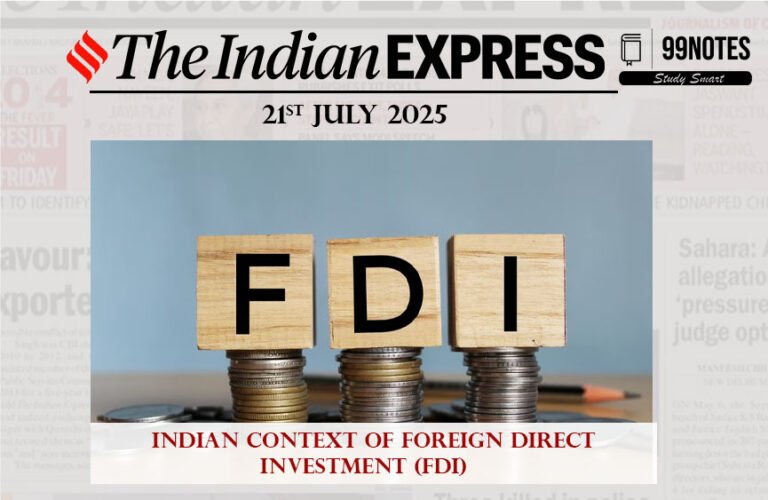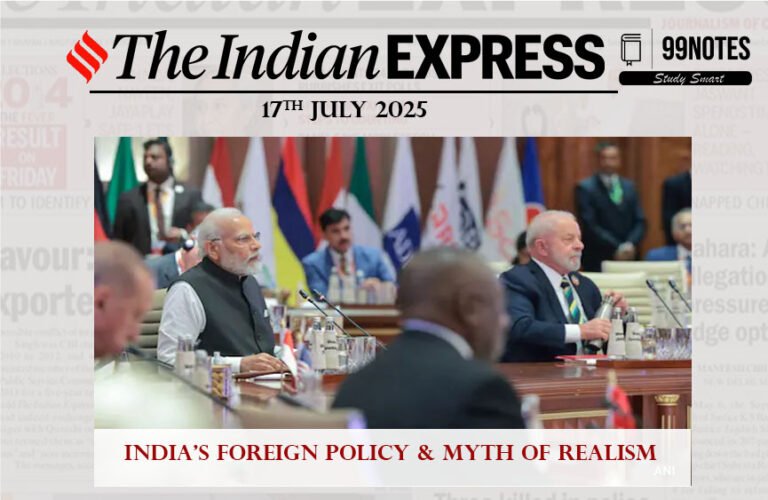29 Dec 2023 : Indian Express
Indian Express
29- December-2023
1. NOT ZERO SUM
| Topic: GS2 – International Relations- Bilateral Relations This topic is not much relevant in the context of Prelims but more for Mains in the context of changing trends in Indo-Russia relations. |
| Context: |
|
Economic Engagement and Geopolitical Interests:
Surge in Economic Engagement:
- The previous two years have seen a dramatic increase in bilateral commercial and economic cooperation between Russia and India, despite the perception of a deteriorating relationship.
- Huge oil imports from Moscow have propelled the growth of bilateral trade, which reached $50 billion last year.
- Delhi remained devoted to a constructive partnership with Moscow in the face of Western censure on India’s position on Russia’s incursion into Ukraine.
Preserving National Security Strategy:
- India’s determination to resist Western pressure was based on the belief that maintaining relations with Moscow is an essential component of the country’s national security plan.
- The goal of Jaishankar’s visit is to continue high-level political interaction, and it emphasises how crucial India-Russian relations are to preserving a steady power balance in Asia.
Evolving Dynamics and Strategic Partnership:
Changing Context:
- The Indo-Russian relationship’s context has undergone a significant shift. India, no longer dependent on Russia for help, is no longer a submissive junior partner.
- Since 1991, there has been a significant change in the economic landscape, with India’s GDP now exceeding Russia’s.
- With France and the US emerging as significant arms suppliers, India is diversifying its reliance on foreign military power.
Equal Partnership:
- India is reestablishing its partnership with Russia on an equal footing and severing its historical reliance.
- The US and India continue to have a strong strategic cooperation, and the recent incident with Gurpatwant Singh Pannun does not indicate a significant change in India’s relations with the US.
- Washington and Delhi are taking proactive measures to handle the incident’s fallout.
Strategic Considerations and Global Dynamics:
Diversification and Ties with the West:
- India is becoming more and more connected to the US, Europe, and the UK in terms of trade and technology.
- These important connections are strengthened by the substantial presence of the Indian diaspora in the English-speaking globe.
- Moscow and Delhi value a prudent bilateral relationship to manage the geopolitical fault line between Washington and Beijing, despite the increasing level of cooperation between the two cities.
Conclusion:
- India and Russia recognise that they are on different sides of the global geopolitical fault line, but they both want to maintain a reasonable bilateral relationship.
- They view this partnership as a way to increase their flexibility in a world that is becoming more and more bipolar, where their shared ideals are vital in the face of shifting global power dynamics.
| What is the Significance of Russia for India? |
|
| PYQ: What is the significance of Indo-US defence deals over Indo-Russian defence deals? Discuss with reference to stability in the Indo-Pacific region. (250 words/15m) (UPSC CSE (M) GS-2 2020) |
| Practice Question: Analyse the dynamics of the Indo-Russian relationship in the context of changing global geopolitical scenarios. (150 words/10 m) |
2. An AI for the people
| Topic: GS3 – Science and Technology- Developing New Technology- IT and computers. This topic is relevant for both Prelims and Mains in the context of developments and challenges related to artificial intelligence in 2023 |
| Context: |
|
Industry Response and Developments:
Microsoft’s Investment and Virality of ChatGPT:
- Motivated by ChatGPT’s viral popularity, Microsoft invested $10 billion in the OpenAI initiative at the beginning of the year.
- ChatGPT emerged as the AI app with the fastest growth rate by February. Google unveiled Bard, their chatbot, in an effort to stay ahead of the curve.
- These advancements had an impact on hardware revenue; as a result, NVIDIA’s market capitalization surpassed $1 trillion.
- With Bedrock, Amazon also made a splash in the market by giving users access to Titan, one of its own massive language models.
Integration of Generative Models:
- In response to the excitement surrounding AI, Google and Microsoft have announced plans to improve their platforms.
- Microsoft wanted to incorporate generative models for Windows 11 navigation, whereas Google wanted to employ them for search engine optimisation.
Awareness of AI Risks and Perils:
Verbalizing Dangers of LLMs:
- During this time, industry and government players started to recognise the dangers of LLMs, a viewpoint that policy experts and AI experts have long emphasised.
- But up until now, the industry had disregarded these worries.
- The appearance of the AI safety letter, which was signed by more than 2,900 professionals, demanded a six-month moratorium on the training of AI systems more potent than GPT-4, citing existential concerns about the imminence of AGI.
- Overlooking Political Economy and Concrete Harms:
- The political economy around AI, including concerns about data privacy, working conditions, and the unpredictable nature of AI’s influence on democratic processes, was not included in the AI safety letter.
- Actual harms from AI systems, which are now commonplace, were eclipsed by an industry-focused emphasis on potential threats in the future.
“Doomwashing” Phenomenon:
Inflated Industry Importance and Self-Regulation:
- The fear around AI exaggerated the sector’s significance and strengthened the idea that AI is too complicated for governmental supervision.
- This gave rise to the phenomena known as “Doomwashing,” in which business executives who advise prudence are given the freedom to exercise self-control.
- This trend was demonstrated by the US government’s introduction of “voluntary rules” for AI safety that were free of political or economic constraints.
Regulatory Landscape:
US and EU Approaches:
- The US government convinced tech companies to enact voluntary regulations in July.
- An Executive Order on AI safety was signed by October, although it did not address all of the important issues.
- On the other hand, the EU passed the AI Act in December, making it the first law in history to address AI.
- Critiques, however, draw attention to the regulation’s shortcomings, such as its exclusion of emotion detection outside of the workplace.
Challenges in EU Law:
- Though groundbreaking, the European AI Act has come under fire for lacking provisions regarding topics such as emotion recognition, virtual assistants, and the possible dangers of chatbots.
- AI ownership, labour effect, and profit distribution remain unresolved in the lack of an industrial strategy.
Reflections on the State of AI Policy in 2023:
Democratic Deficiency and Tech Company Dominance:
- By the end of 2023, AI policy will face serious obstacles due to a lack of democratic voices and a tendency to cede control of the policy-making process to a small number of tech firms.
- The true concerns regarding AI are being weaponized to divert attention away from practical solutions.
Conclusion:
- The conclusion highlights the expectation for further socialisation of AI policy by 2024, along with a need for more inclusive engagement and public influence over the creation and imagination of AI policies.
- The conflicting views on AI’s benefits and drawbacks were demonstrated in 2023, which sparked corporate investments and government reactions.
- In the upcoming years, AI policy will need to adopt a more democratic and all-encompassing approach due to the ongoing issues.
| What is ChatGPT? |
|
| PYQ: With the present state of development, Artificial Intelligence can effectively do which of the following? (2020) Bring down electricity consumption in industrial units Create meaningful short stories and songs Disease diagnosis Text-to-Speech Conversion Wireless transmission of electrical energy Select the correct answer using the code given below: (a) 1, 2, 3 and 5 only (b) 1, 3 and 4 only (c) 2, 4 and 5 only (d) 1, 2, 3, 4 and 5 Ans: (b) |
| Practice Question: To what extent did the events and developments in the field of artificial intelligence (AI) during 2023 reflect the dual perceptions of AI’s transformative potential and the emerging awareness of its associated risks, considering industry responses,and the implications for democratic governance?. (250 words/15 m) |
For Enquiry

29 December 2023 : The Hindu Editorial Notes PDF

29 Dec 2023 : PIB

29 Dec 2023 : Indian Express

29 Dec 2023 : Daily Current Affairs

The Scheduled Castes and Scheduled Tribes (Prevention of Atrocities) Act, 1989

Election Commission of India Notes For UPSC

Finance Commission of India – UPSC Exam Notes

Union Public Service Commission (UPSC)

State Public Service Commission (State PCS) UPSC Notes

Election Laws in India Notes for UPSC Exams
December 2023 The Hindu 29 December 2023 : The Hindu Editorial Notes PDF The Hindu Editorial
29-December-2023
1. India’s stationary course in the shipping value chain.
Topic:…
December 2023 Pib 29 Dec 2023 : PIB PRESS INFORMATION BUREAU
29-December -2023
1. Ministry of Corporate Affairs Year Ender 2023
Topic:…
december 2023 indian express 29 Dec 2023 : Indian Express Indian Express
29- December-2023
1. NOT ZERO SUM
Topic: GS2 – International Relations- Bilateral…
Daily Current Affairs 29 Dec 2023 : Daily Current Affairs Daily Current Affairs
29-December-2023
1. Qatar court drops death penalty for 8 Indians, Govt says…
Blogs Upsc The Scheduled Castes and Scheduled Tribes (Prevention of Atrocities) Act, 1989 The SC & ST Act, 1989 (Prevention of Atrocities)
The parliament of India enacted the act to prevent…
Constitutional Bodies Election Commission of India Notes For UPSC Election Commission of India
Election Commission of India (ECI) is a constitutional body constituted…
Constitutional Bodies Finance Commission of India – UPSC Exam Notes Finance Commission of India
Article 280 of the Constitution of India provides for a Finance Commission,…
Constitutional Bodies Union Public Service Commission (UPSC) UPSC
In a democratic government, civil service is a crucial institution responsible for assisting the…
Constitutional Bodies State Public Service Commission (State PCS) UPSC Notes State Public Service Commission
Civil servants play an important role in the administration and governance…
Elections in India Election Laws in India Notes for UPSC Exams Constitutional Provisions Regarding Elections
Part XV of the Indian Constitution deals with Elections….


